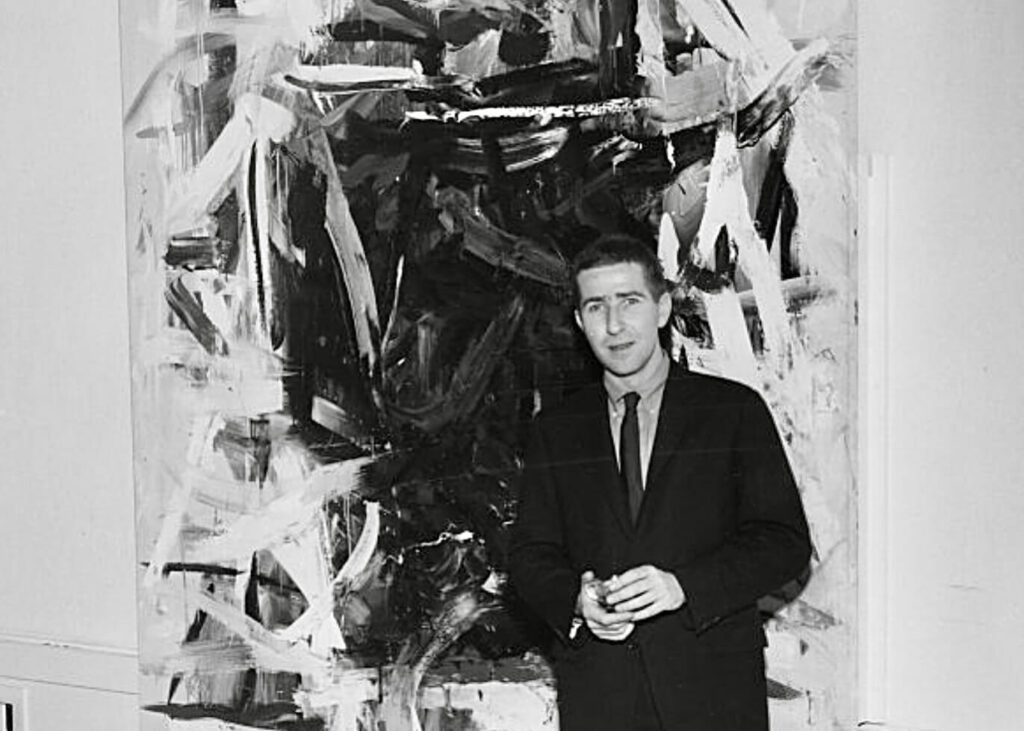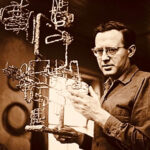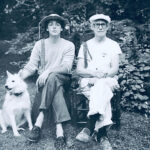Michael Goldberg
Michael Goldberg (1924-2007) was a prominent figure in the Abstract Expressionist movement, known for his dynamic and gestural painting style. His work is characterized by its bold use of color, expressive brushwork, and a relentless exploration of abstraction. Goldberg’s artistic journey reflects a deep engagement with the principles of Abstract Expressionism and a continuous evolution of his unique visual language.

Early Life and Education
Michael Goldberg was born on December 24, 1924, in the Bronx, New York. Growing up in a working-class family, he showed an early interest in art, often drawing and painting from a young age. His passion for art was further nurtured by the vibrant cultural environment of New York City.
After graduating from high school, Goldberg served in the United States Army during World War II. Following his military service, he returned to New York and enrolled in the Art Students League, where he studied under influential artists such as Hans Hofmann and Vaclav Vytlacil. These formative years provided Goldberg with a solid foundation in modern art techniques and exposed him to the avant-garde movements that were shaping the art world at the time.
Transition to Abstract Expressionism
In the late 1940s and early 1950s, Goldberg became deeply involved in the New York art scene, which was undergoing a radical transformation with the rise of Abstract Expressionism. Influenced by artists like Jackson Pollock, Willem de Kooning, and Franz Kline, Goldberg began experimenting with gestural abstraction and exploring the emotional and expressive potential of non-representational art.
Goldberg quickly established himself as a key figure within the Abstract Expressionist movement. His early works were characterized by their dynamic compositions, bold brushstrokes, and vibrant color palettes. He was known for his ability to convey a sense of movement and energy through his paintings, creating works that were both visually striking and emotionally resonant.
Artistic Evolution and Notable Works
Goldberg’s artistic evolution can be traced through several distinct phases, each marked by a deepening engagement with abstraction and a continuous exploration of new techniques and materials.
- “Sardines” (1955)
One of Goldberg’s most celebrated early works, “Sardines,” exemplifies his commitment to the principles of Abstract Expressionism. The painting features a complex composition of gestural brushstrokes, with layers of vibrant colors creating a sense of depth and movement. The use of bold, contrasting colors and dynamic forms reflects Goldberg’s exploration of the emotional and expressive potential of abstract art.
Notable Artwork: “Sardines” (1955)
“Sardines” is a striking example of Goldberg’s ability to convey complex emotions through abstract forms. The painting’s energetic brushwork and vibrant color palette create a sense of intensity and dynamism, drawing viewers into the work. The interplay of light and shadow, combined with the dynamic composition, evokes a feeling of movement and spontaneity. “Sardines” is a testament to Goldberg’s mastery of abstract expressionism and his ability to create powerful, emotive compositions. - “Bacchus” (1962)
“Bacchus” marks a transitional phase in Goldberg’s career, characterized by a shift towards more structured compositions and a focus on the interplay of color and form. In this work, Goldberg used bold, geometric shapes and a limited color palette to create a sense of order and balance. The painting’s clean lines and vibrant colors reflect his interest in exploring the formal aspects of abstraction.
Notable Artwork: “Bacchus” (1962)
“Bacchus” exemplifies Goldberg’s exploration of form and color. The painting’s structured composition and bold, geometric shapes create a sense of harmony and balance, contrasting with the more spontaneous and gestural elements of his earlier works. “Bacchus” highlights Goldberg’s ability to blend gestural abstraction with formal structure, demonstrating his continuous evolution as an artist. - “The Green Eye of the Pyramid” (1972)
In the later stages of his career, Goldberg’s work became more experimental, incorporating elements of collage and mixed media. “The Green Eye of the Pyramid” is an example of this shift, featuring a complex composition of layered materials and textures. The painting’s rich surface and intricate details invite viewers to explore its subtle variations and intricate patterns.
Notable Artwork: “The Green Eye of the Pyramid” (1972)
“The Green Eye of the Pyramid” is a powerful example of Goldberg’s innovative approach to mixed media. The painting’s layered composition and rich textures create a sense of depth and complexity, inviting viewers to engage with the work on a deeper level. The use of collage elements and mixed materials adds a tactile quality to the painting, enhancing its visual impact. This piece highlights Goldberg’s ability to push the boundaries of abstraction and explore new creative possibilities.
Legacy and Influence
Michael Goldberg’s contributions to Abstract Expressionism and his continuous exploration of abstraction have left a lasting impact on the art world. His work is celebrated for its emotional depth, technical mastery, and innovative use of color and form.
- Influence on Abstract Expressionism: Goldberg was a key figure in the development of Abstract Expressionism, contributing to the movement’s emphasis on gestural abstraction and the expressive potential of non-representational art. His work helped to define the movement and expand its expressive possibilities.
- Impact on Subsequent Generations: Goldberg’s innovative approach to abstraction and his exploration of new techniques and materials have influenced subsequent generations of artists. His emphasis on the emotional power of abstract forms and the importance of experimentation continues to resonate with contemporary artists exploring the boundaries of abstraction.
- Continued Relevance: Goldberg’s work remains relevant and celebrated in the art world, with his paintings held in major museum collections worldwide, including the Museum of Modern Art in New York, the Whitney Museum of American Art, and the Smithsonian American Art Museum. His influence can be seen in the work of contemporary artists who explore themes of abstraction, color, and the expressive potential of form.
Personal Life and Later Years
Despite his significant contributions to the art world, Goldberg faced several personal and professional challenges throughout his career. He struggled with periods of financial instability and health issues, but remained deeply committed to his artistic vision. Goldberg continued to create and exhibit his work, maintaining a strong presence in the art world until his death.
In the later stages of his career, Goldberg became involved in teaching and mentoring young artists. He served as a professor at several prestigious institutions, including the School of Visual Arts and the San Francisco Art Institute. Goldberg’s dedication to fostering creativity and innovation continues to inspire new generations of artists.
Michael Goldberg passed away on December 30, 2007, leaving behind a rich legacy of innovative and emotionally resonant artworks. His contributions to Abstract Expressionism and his exploration of the expressive potential of abstraction continue to inspire and captivate audiences worldwide.
Conclusion
Michael Goldberg’s artistic journey is a testament to his dedication to exploring the depths of abstraction and his relentless pursuit of artistic authenticity. Through his innovative techniques and distinctive style, Goldberg pushed the boundaries of Abstract Expressionism and left an indelible mark on the history of modern art. His notable works, such as “Sardines,” “Bacchus,” and “The Green Eye of the Pyramid,” exemplify his mastery of color, form, and composition, highlighting his unique approach to abstract painting.
In celebrating Michael Goldberg’s life and work, we recognize his significant contributions to the development of Abstract Expressionism and his enduring legacy as a pioneer of abstract art. His paintings continue to inspire and captivate, reminding us of the power of art to evoke profound emotions and push the boundaries of human creativity.



